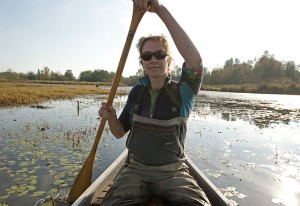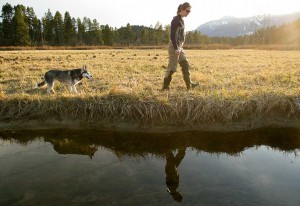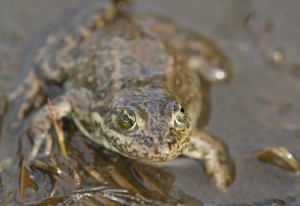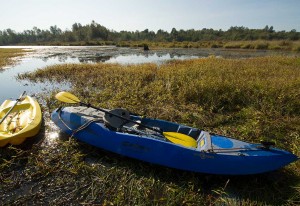The Gems of the Swamp: Looking for amphibians with Monica Pearson
By Isabelle Groc, Toad People Co-Director / Wilderness Committee BC Species at Risk Project Coordinator

Join Monica Pearson on an exclusive wetland field trip to see Oregon spotted frogs and other endangered BC amphibians. (Photo: Isabelle Groc)
When she was two years old, Monica Pearson lived close to Camosun Bog in Vancouver’s Pacific Spirit Regional Park. She spent most of her time outside sitting on a trail and playing with plants.
Her fascination for all things wild never faded, and as an adult she became a conservation biologist specializing in at-risk amphibians and wetland habitat restoration in British Columbia. Her favourite part of her work is designing and building habitat – a task she compares to sculpting with an excavator.
For the last eight years, Monica has been studying the secret life of one of the most beautiful and cryptic gems of the wetland, the Oregon spotted frog.
The species is found in Washington and Oregon, and once also lived in California, but those populations have been lost. In Canada, British Columbia’s Fraser Valley is the only location Oregon spotted frogs in the country.
Historically, they occurred throughout the Fraser Valley, from South Surrey to Hope. Now there are only six breeding populations left in the province.
With less than 500 breeding females in total, the Oregon spotted frog is Canada’s most endangered amphibian. The primary cause for the decline has been the loss of wetlands as the Fraser River floodplain was drained for agriculture. The impact is even greater when agricultural land is further converted to housing and urban development.
Monica has generously offered to take three lucky nature-lovers out on a private field trip to search for Oregon spotted frogs and other amphibians in the Fraser Valley’s wetlands. It is one of the unique perks available for contributing to our Toad People crowdfunding campaign.
By the end of their field trip with Monica, participants will expertly tell the difference between a bog, a marsh, a swamp and a wetland, and they will have had close and rare encounters with a variety of amphibian species that are normally very difficult to see.
The Latin name of the Oregon spotted frog, Rana pretiosa, means “precious frog,” and is a reminder of the spectacular and very photogenic appearance of the frog.
This field trip with Monica is a particular treat for photographers! Bring an assortment of lenses because you will have many great opportunities – go wide, go close, go fish eye! You can experiment with underwater photography in shallow water, get wide-angle shots of pristine landscapes, and capture the bright golden eyes of the Oregon spotted frog with your macro lens. You can get it all in one day in the field!
Click here to visit the Toad People Indiegogo crowdfunding page and claim this perk today.
————
Read on for a Q &A with Monica, about her love of the wetlands and what guests can expect to see on the field trip.
Toad People: Why do you study frogs?
Monica: I have an affinity for the connection between land and water, and frogs live in that space. So more than the frogs, I am interested in the place and the interaction that everything relies on. The large wildlife, the small wildlife, the fish, the frogs – everything needs the interaction of terrestrial and aquatic. What I find interesting is that zone between wet and dry. It moves, it changes, and there is so much diversity in there.
The Oregon spotted frog is a symbol of that space and that interaction. It is also one of these endangered species that I think it is possible to recover. It is possible for humans and Oregon spotted frogs to live in the same landscape. Oregon spotted frogs are completely compatible with sensitive humans. They are not compatible with [their habitat] being paved over, but they are compatible with an agricultural landscape, a rural, or semi-urban landscape.
Toad People: What do you love about the Oregon spotted frog?
Monica: It is an interesting species, it is fun to handle, it is approachable, and it is a species that you can learn from and learn about.
Toad People: What can participants expect to see on your field trip?

Monica’s work is not just about the frogs but about the interaction between species and their complex environment. (Photo: Isabelle Groc)
Monica: We would set out some traps ahead of time so we would be able to catch Oregon spotted frogs, northern red-legged frogs and northwestern salamanders, as well as some fish, salmonids, sticklebacks and other species. We would go out to the historic sites where we have had Oregon spotted frogs, and we will explore these spaces in waders. I would also bring them to restoration sites and show them how the frogs use the habitat. Kids and adults love seeing what comes out of those traps. Photographers will have a chance to see and photograph the small things and species that they would never see otherwise.
Toad People: What does the landscape look like?
Monica: Participants would see a variety of pristine landscapes, altered and restored ecosystems. We will have conversations about the landscape, the history and the geography of the Fraser Valley, and how since colonization we have used and altered the landscape for our needs, how that has affected the river and how the river still affects us.
Toad People: What will have participants learned at the end of the day?
Monica: I hope they would have a stronger knowledge and appreciation of the landscape, how we have changed it, how these changes affect the amphibians as well as the humans, and what we can do. They will have learned about those different species, having seen the small and hidden things, the gems of the swamp.
For more information on Oregon spotted frogs and Monica’s work in the field, watch the Wilderness Committee’s video, Precious Frog, and check out this article to read how conservation canines are used in the wetlands to search for the frogs.


